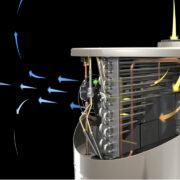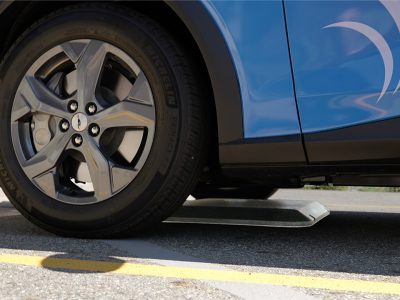This is a tech channel, so why am I talking about cars? Well, I’m a big believer in going green and how tech can help with that. A few years ago I made the jump to a plug-in hybrid, this Ford Fusion Energi Titanium, to try and reduce my emissions and save money on gasoline. How’d it work out? Was it worth it? And how do I think it will compare to a fully electric car, like the Tesla Model 3 … which I’m finally picking up this week!
The average American commute is a little over 30 miles a day and mine was averaging just north of 40 miles, so I really wanted to see if I could save some cash and reduce my emissions. While I really wanted a Tesla, it was way out of my league for cost … you’re talking close to $100,000 or more, so I started looking at cars like the Nissan Leaf, Toyota Prius, and the Chevy Bolt. Call me vain, but I find most of the hybrid cars ugly … like really, really ugly. That’s how I landed on the Ford Fusion Energi, which is a plug-in hybrid. It reminds me a lot of an Aston Martin DB9, which I think is an absolutely gorgeous car … of course, the Ford costs about $300,000 less than an Aston Martin … so there’s that.
The Ford Fusion Energi has a 7.6kWh battery that gets you roughly 20 miles of electric range before switching over to a more traditional hybrid like the Toyota Prius. Of course, that’s 20 miles in perfect conditions. In the cold New England winters I could see that cut in half. But for the most part, this meant I should be getting into work on pure electric and driving home as a hybrid. Not bad.
In comparison to the Nissan Altima, which was the car I had before the Ford Fusion, it was a huge difference. On average I was getting 22.5 MPG in the Altima, but 58.5. MPG in the Fusion.
Pricing that out
- Average gas price in Massachusetts is $2.88/gallon right now.
- I was driving 861 miles per month on average.
- That’s 38.27 gallons at $110.22 in the Nissan vs 14.7 gallons at $42.34 in the Ford.
- That’s a 62% savings in gasoline. And over the course of a year that’s about $814.56 in savings.
But that’s leaving out an important factor, the cost of electricity. Everyday I was charging the Ford to get my 20 miles of battery range. Massachusetts has some of the most expensive electricity in the country (about $0.22 kWh), so you may find a much larger savings here than I did.
The Ford electricity costs worked out to about $0.07 per mile vs. the Nissan at $0.12 per gas mile. That’s only a savings of about $0.05 per mile … but zero emissions. To round out the true cost of running the Ford Fusion, I’d need to add on an average of about $30 for electricity per month.
Final cost: $72.34 per month for the Ford … still a $34.37 per month savings … or a $412.44 per year savings. Not bad at all, but that doesn’t cover the premium of buying the Energi over a regular Ford Fusion. There’s about a $10k spread there.
When you go electric though, it’s not just gasoline and power costs you’re saving money on, you’re also saving on maintenance. I only needed to change my oil in my car once a year instead of 4 or more times. Electric cars use regenerative breaking, which means the electric motors are slowing the car down instead of using the brakes. That ultimately means that your brakes are going to last dramatically longer than on an I.C.E. (Internal combustion engine) car.
But how does it drive?
Well, when you’re on electric, it’s got a nice kick of torque when you punch it, but it’s not the zippiest car on the planet. It’s got a rip roaring 0-60 time of over 8 seconds. Yeah, it’s kind of a poker. Even though it has 141 horse power with gas and 118 horse power with electric, the combined 195 horse power is trying to move a VERY heavy car (about 4,000 pounds). You’re not going to be winning any drag races.
The ride is really comfortable. It’s somewhere in-between a sport suspension and an air ride, like a Buick or Cadillac. It’s definitely not in the Cadillac territory where you could be running over pedestrians and not feel a thing. It’s a smooth ride, but when you hit larger bumps, you definitely feel it.
The Cons
The charge port is manual and takes a good deal of force to get it to stick. There have been more than a few times where I thought I had successfully latched it only to find that it had popped open while driving.
Trunk space is a major problem on the car. When you retrofit an I.C.E. car for electric, there’s only so many places you can squeeze a battery in. For the Fusion, Ford took away half the trunk to make room, which has the fun side effect of making the fold down seats completely useless. You can fold them down, but you only have a few inches of room above the battery compartment. Yeah … that’s useful.
The Microsoft entertainment system feels like it’s being powered with a Commodore 64 computer in there. It may be feature rich, but it’s incredibly sluggish. There was a Ford recall/update for the cellular modem, which I had done, but I haven’t seen any updates in over a year on the car. That means roadways aren’t completely up to date, and I’m not confident in how accurate the traffic data is.
Final thoughts
To be clear, this car has served me well, saved me a lot of gas money, and helped me on my path to going green. But I don’t think it’s worth going with a hybrid nowadays. Over the past couple of years there have been big improvements with electric vehicle range and battery costs have been dropping. You can pick up a brand new Chevy Bolt, which has a range over 200 miles, for under $30,000 now. Add to that state and federal incentives, you’ll find the cost of ownership drops even further. In the U.S. there’s still the $7,500 EV tax credit available for most EVs. Many states have rebates and tax credits of their own, like Massachusetts with a $2,500 rebate. That would make the Bolt closer to a $20,000 car. Add to that the cheaper cost of electricity vs. gasoline and lower maintenance costs. It’s becoming a no brainer to go electric over hybrid or gasoline at this point.
Six months after buying this Ford Fusion, Tesla announced the Model 3, which is the car I really wanted … a more affordable Tesla that’s got amazing range and speed. And I’m finally picking up mine this week. It’s been over 880 days since I placed my reservation for one (not that I’m counting), but my wait is almost over. I’ll be posting more videos on my initial impressions, breakdowns of costs for road trips, how hard it is (or isn’t) to charge, and much more. There are also some ways that I may be able to integrate the Model 3 into my home automation … it is just a big computer with wheels after all. A lot more to come.


















Comments